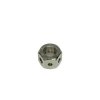Seating depth variations
There are a number of possible causes for overall length variation. One is the way it is measured. If you measure overall length from the tip of the bullet to the base of the case, remember to subtract the variation due to bullet length tolerance. The bullets will vary in length due to manufacturing tolerances (bullets with exposed lead noses are the worst in this regard) and this will add to the overall cartridge length variation. Remember that the bullet seater plug does not (or shouldn't) contact the tip of the bullet when seating, but contacts farther down the ogive. For a more accurate seating depth measurement, take the seater plug out of the bullet seating die, place it on top of the cartridge and measure from the base of the case to the top of the seater plug.
The amount of force required to cycle a progressive press varies with the number of cases in the shell plate. When the shell plate is full, it is harder to lower the lever than when there are one or two cases present. This can lead to variation in cartridge overall length because there are different loads placed on the working parts of the press. When the shell plate is full, seating depth will be slightly long, because the load is higher and all of the clearances are taken up. With the shell plate nearly empty, the load is not great enough to squeeze out these clearances, and the seating depth is short.




